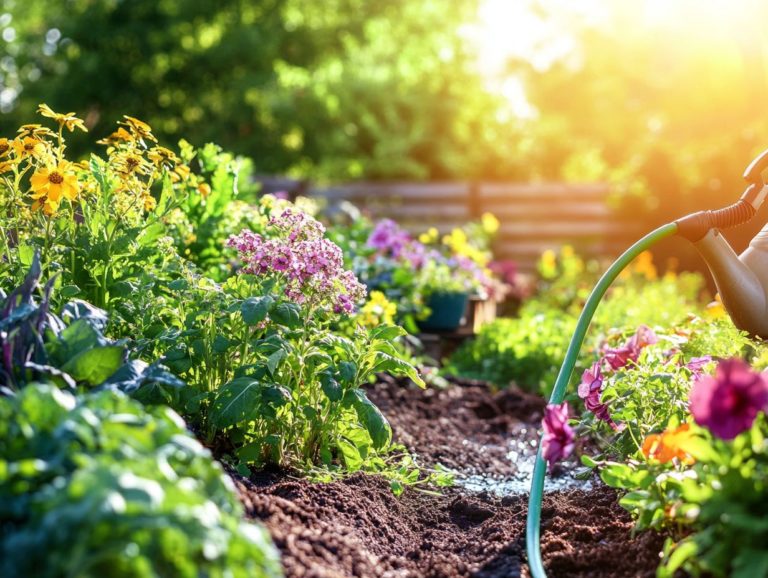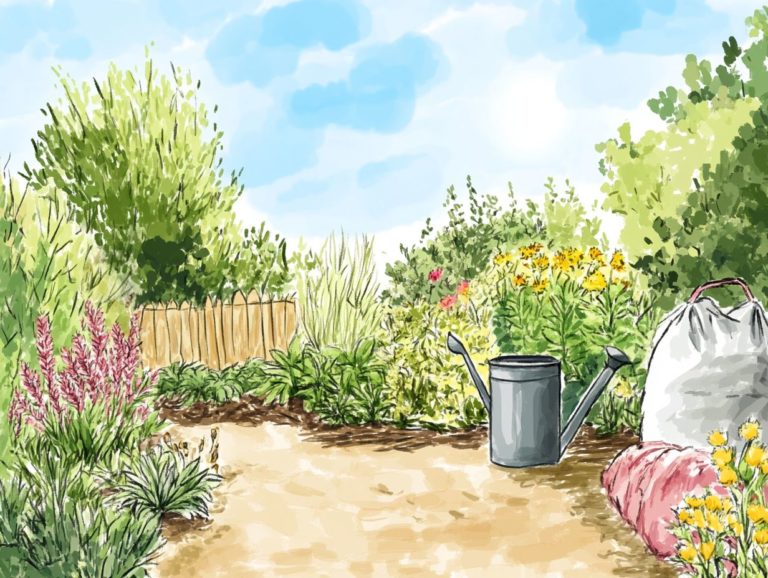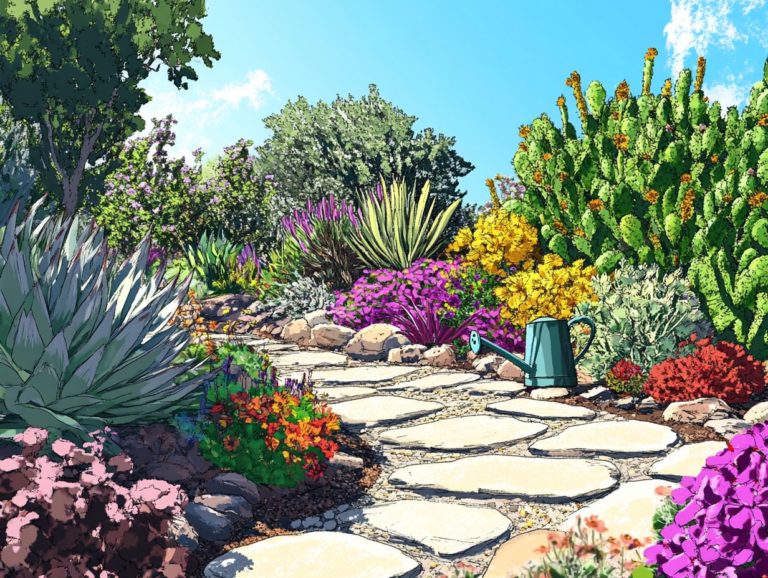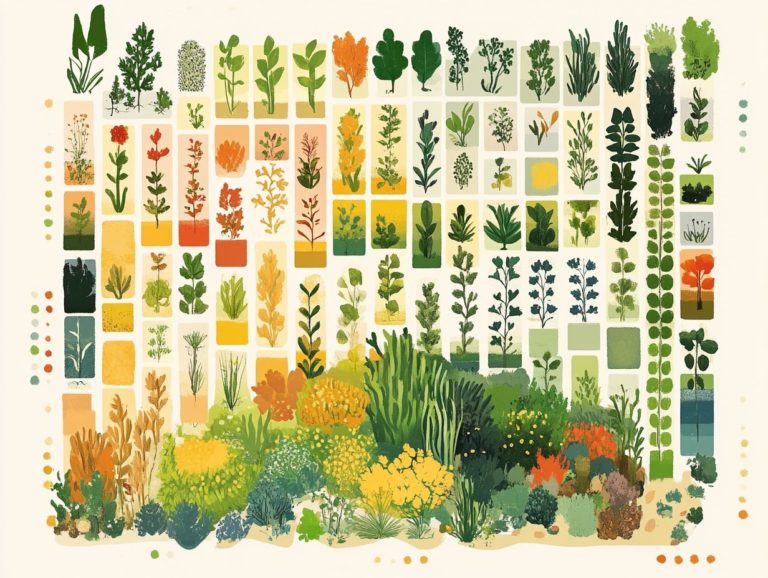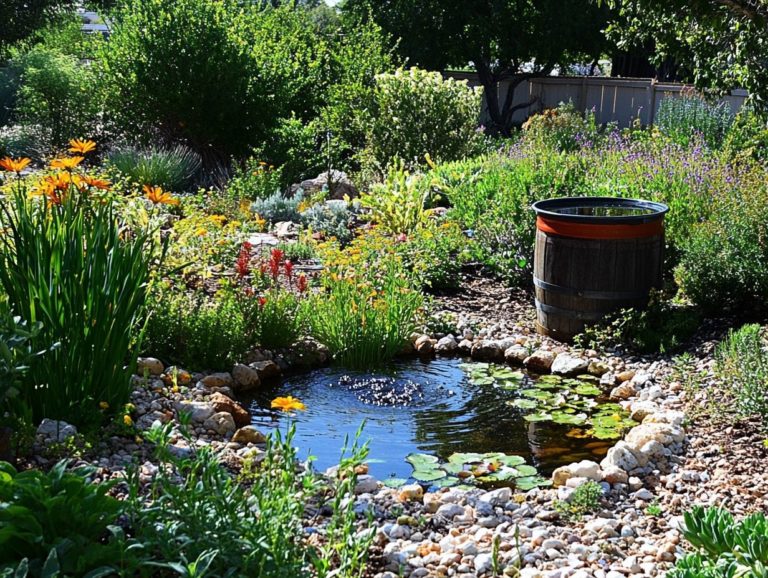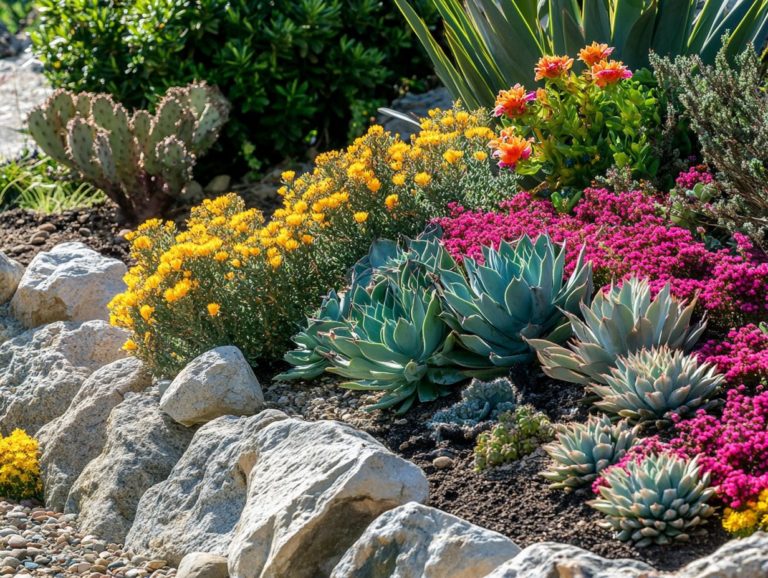Water-Saving Gardening Techniques for Drought
Drought presents considerable challenges for gardeners, directly affecting plant health and overall garden productivity. Grasping the nuances of how drought impacts plants is essential for crafting effective strategies.
This article delves into an array of water-saving techniques designed to empower you to cultivate a flourishing garden, even in arid conditions. You ll uncover valuable insights on selecting drought-resistant plants, implementing efficient irrigation methods, and utilizing mulch to conserve water effectively.
Learn how to create and nurture a garden that thrives in drought while seamlessly integrating everyday water-saving practices to safeguard our invaluable resources.
Contents
- Key Takeaways:
- The Impact of Drought on Gardening
- Essential Water-Saving Techniques for Your Garden
- Creating a Drought-Resistant Garden
- Additional Tips for Water-Saving Gardening
- Frequently Asked Questions
- What are some water-saving gardening techniques for drought?
- How does using mulch help save water in a drought?
- Are there certain types of plants that are better suited for drought conditions?
- Can I still have a lush and beautiful garden while conserving water during a drought?
- How can I capture and reuse rainwater in my garden?
- Are there any other tips for conserving water in the garden during a drought?
Key Takeaways:
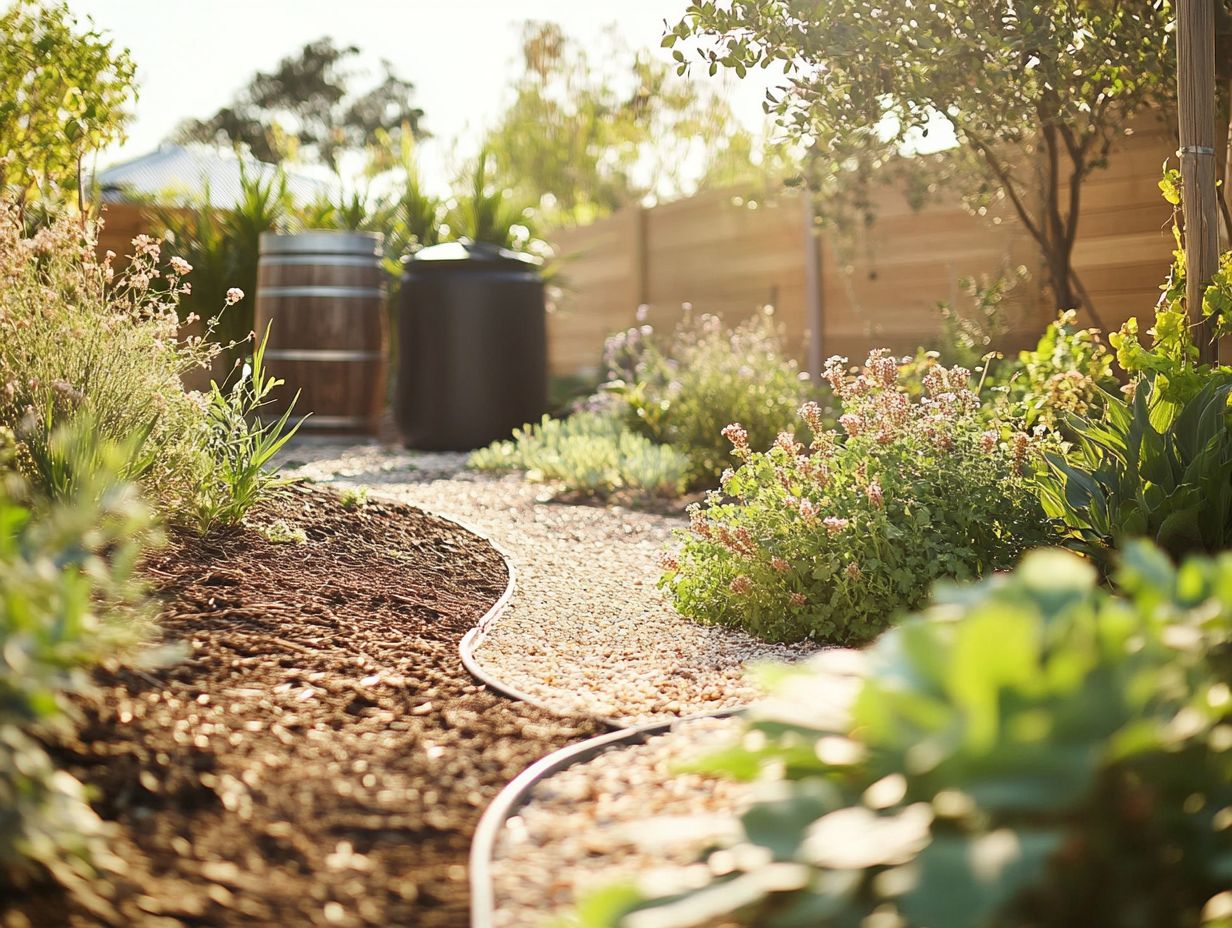
- Choose drought-resistant plants to keep your garden beautiful during dry spells.
- Implement efficient watering methods like drip irrigation and recycling water from sinks or baths to conserve water and keep your plants healthy.
- Design your garden with water conservation in mind, incorporating features like mulch, rain gardens, and native plants to create a sustainable, drought-resistant landscape.
The Impact of Drought on Gardening
The impact of drought on gardening is significant, particularly in areas like California, where water scarcity poses serious challenges to maintaining healthy landscapes and thriving plants. As temperatures rise and rainfall becomes increasingly unpredictable, it s crucial to adapt your gardening practices to ensure that your garden not only survives but flourishes amid these harsh conditions.
A deeper understanding of how drought affects soil, moisture retention, and plant health is essential for creating sustainable gardens. By implementing water-efficient techniques and choosing resilient plant varieties, you can learn about the benefits of drought-resistant gardening while conserving water and enhancing the beauty of your home garden.
Understanding the Effects of Drought on Plants
Understanding how drought affects plants is essential for you as a gardener striving to maintain vibrant and healthy growth. When moisture is scarce, it directly impacts plants’ ability to absorb the essential nutrients they need from the soil.
In drought conditions, you’ll notice significant changes in the physiological responses of plants. Their root systems tend to reach deeper in search of moisture, which can alter nutrient uptake efficiency. Certain varieties, like legumes and specific grasses, are particularly affected, as their nutrient absorption capabilities diminish in dry soil. This lack of moisture jeopardizes soil health and diminishes overall plant vigor, making them more vulnerable to diseases and pests.
Therefore, it’s vital to adopt effective strategies to counter these challenges. By ensuring your soil retains as much moisture as possible, you can support a diverse array of plant life even during the driest spells.
Essential Water-Saving Techniques for Your Garden
Water-saving techniques for gardening are pivotal in fostering sustainable practices, especially in today’s climate where reducing water usage can profoundly influence environmental conservation and the overall health of your garden. To learn more about these strategies, check out the best resources for drought gardening. By embracing efficient irrigation methods, incorporating gray water systems, and utilizing rainwater harvesting techniques, you can conserve water while maintaining the beauty and vibrancy of your landscapes.
Implementing these practices not only enhances your garden but also supports broader regional initiatives in managing water resources during increasingly challenging drought conditions.
In conclusion, by understanding the impact of drought and adopting effective water-saving techniques, you can create a resilient garden that thrives even in the toughest conditions with the right tools. For more details, check out essential tools for drought gardening.
Choosing Drought-Resistant Plants
Choosing drought-resistant plants is essential for crafting a sustainable landscape that flourishes even in harsh water conditions, particularly in areas prone to drought.
By selecting native species, you can enjoy a stunning array of colors and textures that elevate the visual appeal of your garden while providing a sanctuary for local wildlife. These plants are naturally suited to their environment, requiring less maintenance and minimizing the need for chemical fertilizers and pesticides.
Consider incorporating varieties like California poppies and lavender into your garden. They offer resilience and vibrant blooms, enhancing various garden designs, from sleek water-efficient landscaping a method that reduces or eliminates the need for irrigation to charming rustic cottage gardens.
Planning your landscape with these hardy species conserves water and nurtures a healthier ecosystem, ensuring your garden remains lush and vibrant through tough seasons.
Implementing Efficient Irrigation Methods
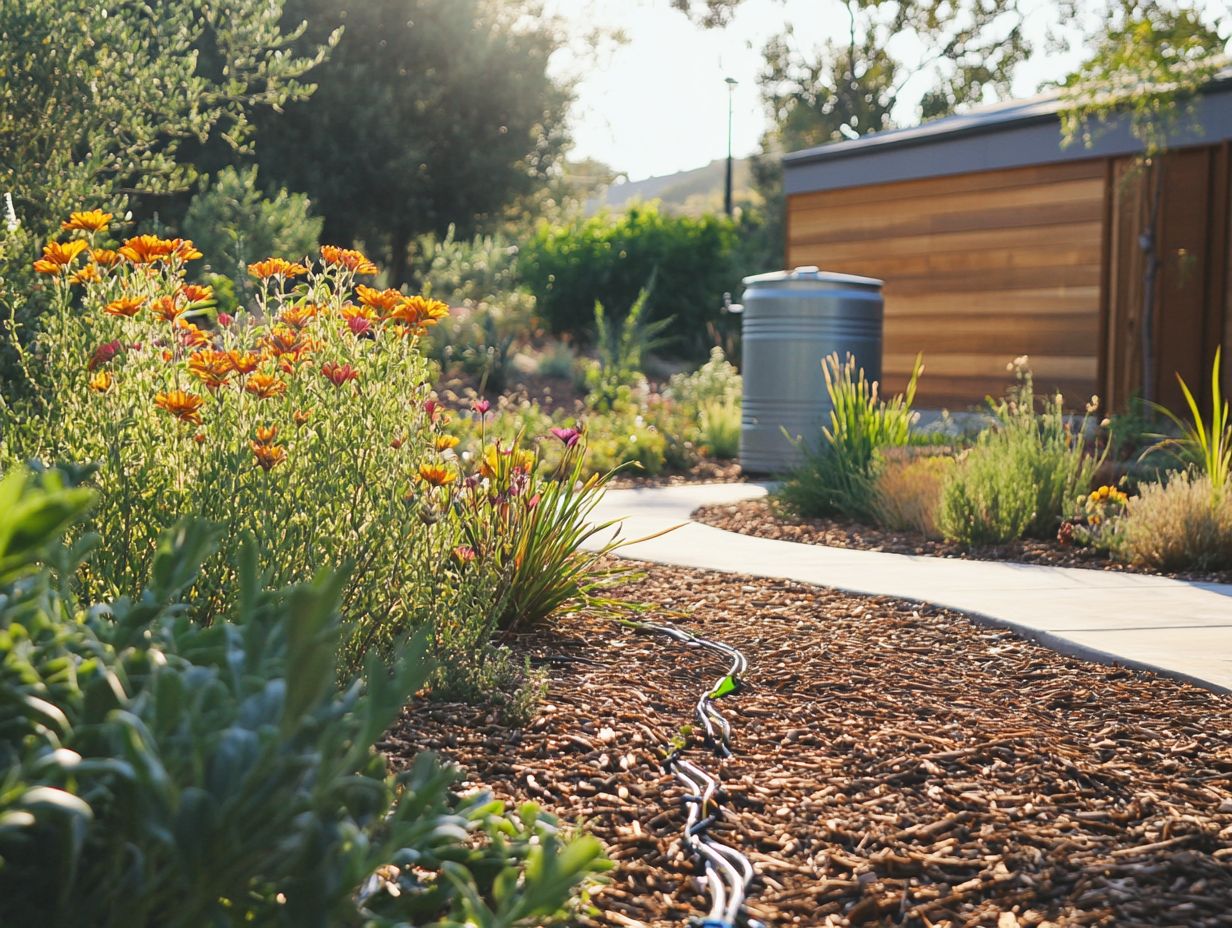
Maximize moisture retention in your garden with efficient irrigation methods while minimizing water waste, especially during scorching summer months.
Explore techniques like drip irrigation, which delivers water directly to the roots of your plants, significantly reducing evaporation and runoff. Soaker hoses also provide a practical solution by allowing water to seep slowly into the soil and ensuring even moisture distribution.
If you’re keen on embracing technology, smart watering systems can monitor weather conditions and soil moisture levels, optimizing your water usage and enhancing energy efficiency.
Each of these methods plays a crucial role in effective moisture management, creating a sustainable gardening experience that conserves precious water resources while nurturing healthy plant growth.
Utilizing Mulch and Other Water-Saving Strategies
Utilizing mulch and innovative water-saving strategies enhances soil moisture retention, reduces evaporation, and promotes healthy plant growth in drought-prone areas.
By implementing mulching techniques effectively, you can significantly cut down on the frequency of watering an essential consideration in regions facing water scarcity. Organic materials like wood chips, straw, and grass clippings enrich the soil as they decompose, providing essential nutrients to your plants and fostering a healthier landscape. In contrast, inorganic mulches such as rubber or gravel create lasting barriers against weeds while maintaining optimal ground temperatures.
To maximize these benefits, ensure a layer of 2 to 4 inches of mulch is applied correctly. Using permeable materials encourages better drainage, ultimately supporting the overall vitality of your garden while embracing sustainable landscaping practices.
Creating a Drought-Resistant Garden
Creating a drought-resistant garden requires a blend of thoughtful design and strategic planning, prioritizing sustainable practices that support local wildlife, including vital pollinators like bees and butterflies.
By integrating drought-tolerant plants, efficient irrigation systems, and organic materials, you cultivate landscapes that thrive in low-water conditions while enhancing biodiversity.
This approach not only conserves water but nurtures a resilient ecosystem that benefits the local environment and elevates the overall health of your landscape.
Start planning your drought-resistant garden today to conserve water and support our environment!
Designing a Garden with Water Conservation in Mind
Designing your garden with water conservation in mind is crucial for minimizing water usage while enhancing both aesthetic appeal and ecological benefits.
Implement thoughtful design techniques to elevate your approach. Proper plant placement is key; position flora that thrives in similar moisture levels to dramatically reduce your irrigation needs.
Grouping native species cultivates a harmonious landscape and fosters biodiversity. This enhances resilience against pests and diseases. Create microclimates such as using shade from larger plants or structures to help retain moisture and optimize growing conditions.
These methods contribute to a sustainable ecosystem while enriching the overall beauty and functionality of your garden.
Maintaining a Drought-Resistant Garden
Maintaining a drought-resistant garden requires consistent care to ensure that plants receive essential nutrients and moisture to thrive in challenging conditions.
Adopt best practices like mulching an effective method for conserving moisture and select native or drought-tolerant plant varieties to enhance sustainability. Regularly monitor soil health; testing for nutrient levels and pH allows informed decisions about applying organic amendments.
Employ techniques like drip irrigation for optimized nutrient delivery, ensuring water penetrates deeply without waste. This thoughtful approach bolsters plant vitality and cultivates a resilient ecosystem, equipping your garden to withstand dry spells.
Additional Tips for Water-Saving Gardening
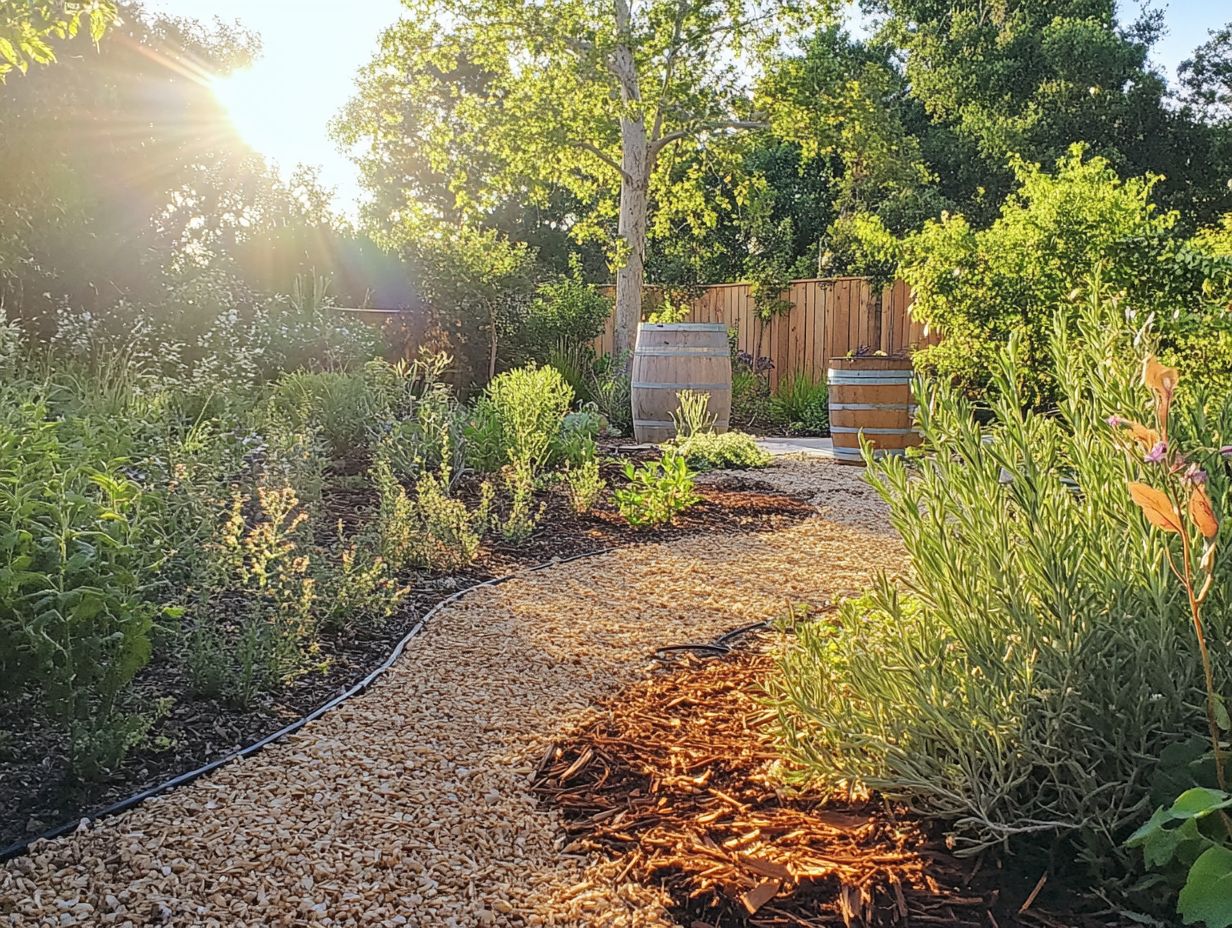
Incorporating additional tips for water-saving gardening can greatly elevate your conservation efforts. It refines the overall efficiency of your garden management practices.
Implement these exciting strategies to contribute to sustainability while cultivating a thriving garden that uses minimal resources.
Conserving Water in Everyday Gardening Tasks
Conserving water in your everyday gardening tasks is vital for fostering sustainable practices. Ensure your plants receive the moisture they need without wasting a drop.
Focus on efficient watering techniques, such as using drip irrigation systems. These systems deliver water directly to the roots, minimizing evaporation and runoff. Enhance your soil by incorporating organic matter to improve moisture retention, meaning you won t have to water as often.
When selecting plants, choose native or drought-resistant varieties to cut down on water consumption while still providing beautiful blooms and foliage. By implementing these mindful practices, you can maintain a flourishing garden that looks good and positively contributes to environmental and water conservation efforts.
Other Ways to Help Conserve Water in Your Garden
Exploring alternative methods to conserve water in your garden elevates the sustainability of your gardening practices and promotes plant health and biodiversity.
Techniques like rainwater harvesting significantly reduce reliance on municipal water supplies, allowing you to collect and utilize natural rainfall.
Integrating gray water reuse repurposing water from baths, sinks, and washing machines provides an eco-friendly solution for irrigation, turning everyday waste into a resource.
Adopt innovative gardening practices such as xeriscaping and planting drought-resistant species. These not only complement conservation methods but also foster a resilient ecosystem.
Implement these strategies to cultivate a vibrant garden that conserves precious resources while enhancing your landscape.
Frequently Asked Questions
What are some water-saving gardening techniques for drought?
Some water-saving techniques for gardening during a drought include using mulch to retain moisture, choosing drought-resistant plants, and capturing and reusing rainwater.
Act now to save water! Start implementing these water-saving tips today!
How does using mulch help save water in a drought?
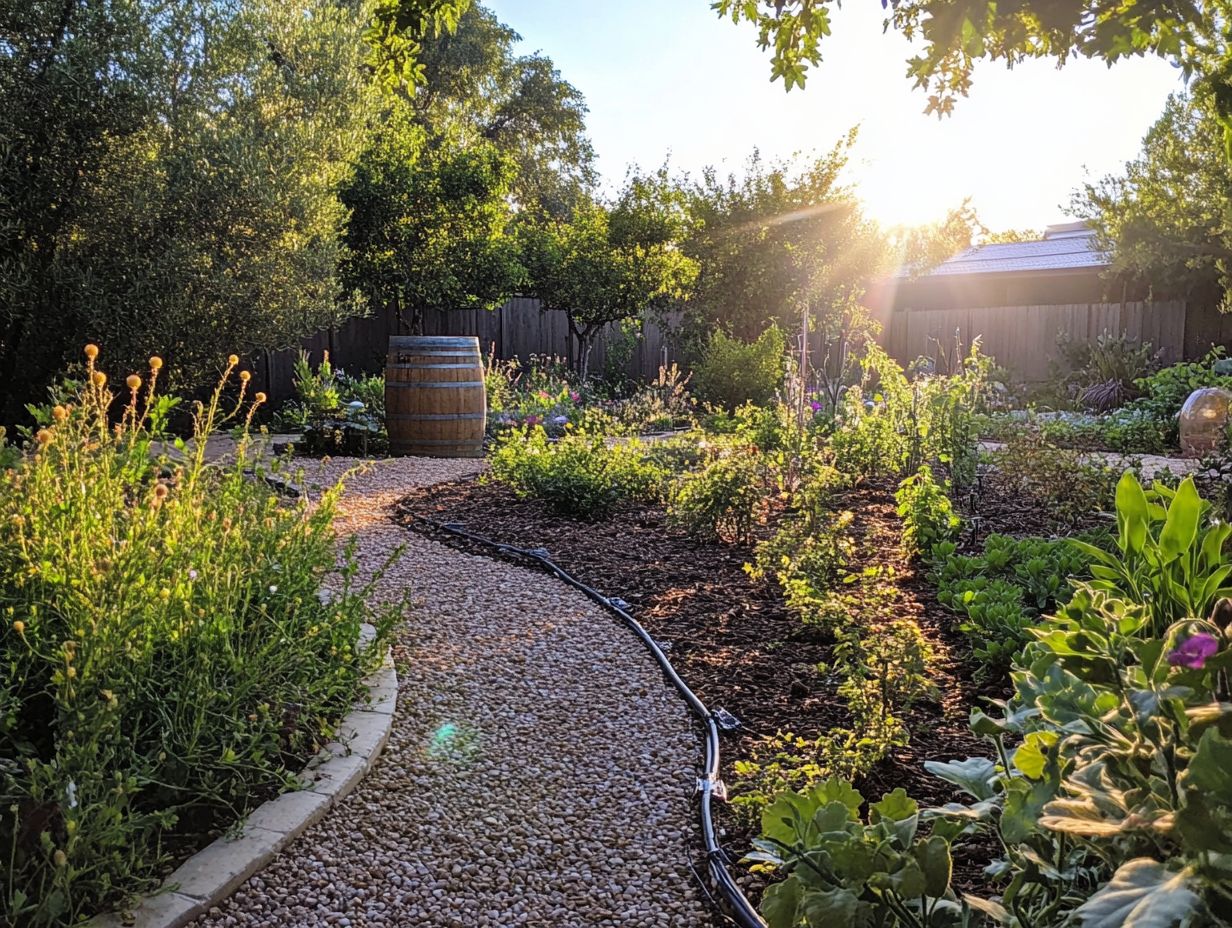
Mulch helps to retain moisture in the soil. This reduces the need for frequent watering.
Are there certain types of plants that are better suited for drought conditions?
Yes, many plants need less water to thrive. Some examples are succulents, cacti, lavender, and rosemary.
Can I still have a lush and beautiful garden while conserving water during a drought?
Absolutely! With water-efficient plants and smart watering techniques, your garden can thrive beautifully while conserving water.
How can I capture and reuse rainwater in my garden?
You can set up a rain barrel or cistern to capture rainwater from your roof. This water can then be used to water your garden, reducing your reliance on other water sources.
Are there any other tips for conserving water in the garden during a drought?
You can also use drip irrigation instead of sprinklers. Water plants deeply and less frequently, and fix any leaks in your system.

